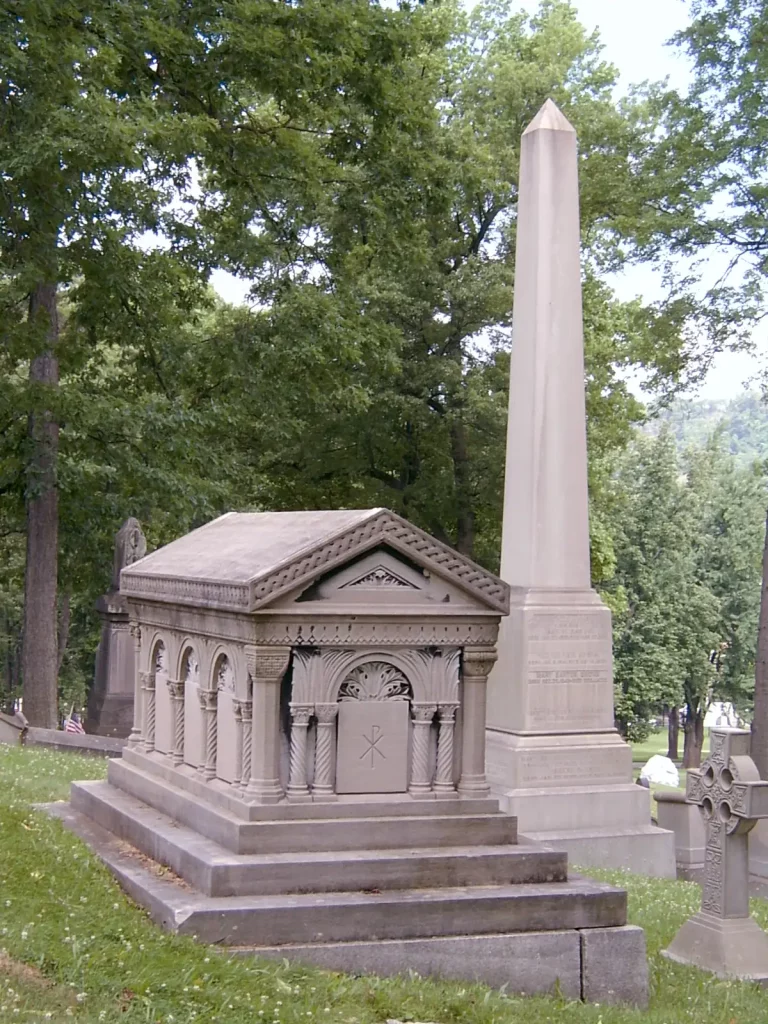
Clarke, according to the cemetery site, was a riverboat and railroad operator. The monument was erected in 1886.
Section: 16
Lot: 120


Clarke, according to the cemetery site, was a riverboat and railroad operator. The monument was erected in 1886.
Section: 16
Lot: 120


Her maiden name is much larger than her husband’s name; she is buried with the rest of the Horners; her elaborate monogram is her unmarried initials (but that is perhaps proper Victorian etiquette). Her married name is so inconspicuous, in fact, that the cemetery site lists this monument under the name Horner. There is a story here, a Victorian three-volume novel about a young woman from a wealthy family who married beneath her, who died tragically young, and whose family never really accepted her marriage. Or perhaps the story is something else entirely. This is not the only example of a young bride buried under her maiden name: Sallie Negley, “Wife of Dr. David M. McMasters,” has a beautiful romantic-style monument in the Negley-Mellon family plot.

Section: 20
Lot: 5

This Romanesque sarcophagus looks particularly elegant with its details outlined in good old Pittsburgh soot.


Section: 2
Lot: 14
This gorgeous Pre-Raphaelite window is at the back of the George J. Schmitt mausoleum in the Union Dale Cemetery, where the rich and influential of Allegheny City went to slumber in eternal style. Its Grail imagery seems to combine two forms of the Grail legend (the Grail as cup of the Last Supper and the grail as mystical jewel). The legend below reads, “Unto thee O Lord do I lift up my soul.”
Anyone worth knowing in the Union Dale cemetery has stained glass in his mausoleum. In fact, for a while in the early 1900s, it was fashionable to have a portrait of the deceased rendered in glass.
Here, for example, is Mr. William H. Walker (1841-1904), who was apparently a proud Shriner. His portrait has deteriorated a little, but not so much that you would not recognize him at once if you met him in the street.
 Mr. William H.Teets (1845-1906; perhaps stained-glass portraits were offered only to men named William H.) has also deteriorated a little, but the portrait is still lifelike enough that you can almost feel the macassar oil.
Mr. William H.Teets (1845-1906; perhaps stained-glass portraits were offered only to men named William H.) has also deteriorated a little, but the portrait is still lifelike enough that you can almost feel the macassar oil.
 Cherubs and lilies adorn the mausoleum of the McLain family. The cherubs’ faces seem to be executed with a degree of skill that the rest of the composition lacks; perhaps they were ordered from a catalogue.
Cherubs and lilies adorn the mausoleum of the McLain family. The cherubs’ faces seem to be executed with a degree of skill that the rest of the composition lacks; perhaps they were ordered from a catalogue.
 The Enlow-Schwer mausoleum, built in the late 1930s, affects a more abstract symbolism.
The Enlow-Schwer mausoleum, built in the late 1930s, affects a more abstract symbolism.
 Finally, a Good Shepherd window, which could probably be ordered in standard sizes from national dealers, adorns the Short mausoleum.
Finally, a Good Shepherd window, which could probably be ordered in standard sizes from national dealers, adorns the Short mausoleum.
There are some who would question the wisdom, or the taste, of building an extravagant monument to the memory of the deceased. Father Pitt would like to suggest, however, that money laid out on art that is still giving us pleasure after a century is hardly misspent.

This monument in the Victorian Romantic style is such a jumble of metaphors that old Pa Pitt is reluctant to try to untangle it. A number of elements—calla, ferns, cushion, scroll, drapery, rustic seat—are rendered individually with great realism, but thrown together in an extraordinarily unlikely way. The monument can be found (but probably won’t be found by most people) in a nearly forgotten German Lutheran cemetery on a hillside in Beechview.